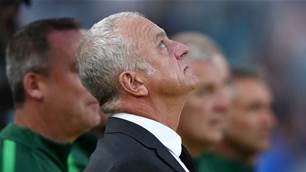Are we better off without alcoholic sponsors? And does not drinking make you any less of a fan?
Alcohol. Love it or hate it, it’s been a fixture of sport in the western world for as long as we can remember. The fans drink it, the players are sponsored by it, and the stadiums serve it. It is part and parcel of not just Australia’s sporting culture, but our wider everyday lives as well. Yet it’s also an addictive drug, well-recognised as having severe effects on health, and contributing to something like $15 billion worth of costs to the community each year through crime, violence, or health issues.
So it comes as little surprise that the recent news of the FFA and Federal Government settling on a deal that would end alcohol sponsorship in the A-League has generated a lot of talk in football circles around the pros and cons of this move. On one hand, a positive health message is being sent to millions of youngsters who play the game – but on the other, clubs are being robbed of yet another potential avenue of revenue at a time when owners continue to worry about the availability of sponsors that do not conflict with brands already backing the FFA. Personally, I looked beyond this and started to wonder about the relationship between alcohol and football fans in general.
I’m certainly not the first to do this – Nick Hornby opined in Fever Pitch that in his experience most fans agreed that drink contributed to English fans’ bad overseas reputation at World Cups and European tournaments. He also demonstrated the intricate link between the round ball game and their alcoholic sponsors in the UK; speaking about the banning of alcohol at first division matches following the Heysel disaster of 1985, Hornby bitterly states:
“…If nothing else, it showed that we were serious about our repentance. The ban could have been taken as a small but felt token towards those boys in Italy who had had too much to drink. And what happened? The clubs whined because it affected their relationship with their more affluent fans, and the ban was lifted… The rule had changed from ‘no alcohol’ to ‘no alcohol within sight of the pitch’, as if the heady combination of grass and whisky had enraged us all and turned us into lunatics. So where had all the hair-shirt penitence gone? What, practically, were the clubs doing to prove that we were one day capable of getting a grip on ourselves, and that one day we would be able to play other European teams without wiping out half of their supporters?”
Having spent some time in a variety of English stadia during my time in Europe, I would like think that the English have reached a stage where the consumption of alcohol doesn’t lead to disasters or drama on gameday – but it took some doing. Meanwhile, football’s governing body FIFA is so tied to their alcohol sponsorship that they’ve actually forced Brazil to change their laws that ban the sale of alcohol inside stadiums for the duration of the 2014 World Cup. What wonderful bedfellows Budweiser must be for FIFA to be able to dictate to a country what their laws should and should not permit! Not that FIFA General Secretary Jerome Valcke thinks that this is a big thing to ask for, mind:
"Alcoholic drinks are part of the FIFA World Cup, so we're going to have them. Excuse me if I sound a bit arrogant but that's something we won't negotiate."
Of course, the worlds of 1980s English terrace culture, Brazilian world cups, and the modern A-League are vastly different – but the relationship between alcohol and fan is still there for everyone to see. If you have ever spent time with active supporters of any A-League side, before and after a game, there will be alcohol involved. Usually in levels far exceeding the Australian Government’s safe guidelines (If you’re wondering, that’s no more than two standard drinks a day – drinking at higher than this level is recognised as contributing to liver disease, stroke, and cancer). At a guess you will see at least a couple drinking to get drunk, some to fit in and socialise, and some more to quench their thirst on a hot day or help down a chicken parmi. For the majority of my time following Glory, I’ve been one of those people – though in truth I’ve never set out to get drunk, it’s just something that happened now and then.
That puts me in with a fair whack of Australians, too. It’s not like active supporters of A-League clubs are the only people who mix alcohol with sport. I would like to think the average Australian is faily well-behaved when it comes to consuming alcohol at sporting events, but even when they aren’t, it happens across a whole range of codes. You’ll find drunken yobs at the cricket, alcoholic fist-fights at footy games, and cringeworthy loudmouths at the rugby. Any alcohol-related trouble at A-League games is simply a representation of a wider problem at sporting and leisure events, rather than a case of soccer hooliganism. So this article certainly isn’t setting out to decry the devil’s drink as the number one cause of football’s problems in this country; but at the same time, I’m still interested to know why fans – especially in active support – have such a close relationship with it when it comes to gameday.
In part at least I’m sure it comes down to the fact that alcohol is such a social drug. We consume it in groups, and it eases nerves and lowers inhibitions, sometimes to amusing or sadly tragic ends. If you’re not the sort of person who normally belts out a refrain of “Archie Thompson’s A Really Nice Guy”, chances are after a few beers you will at least entertain the thought, if not lead the choir yourself. It can also augment your mood; victories are celebrated that much harder, and sorrows can somehow be drowned more easily in a pint glass than they can in a pineapple juice. Australia’s weather, especially in Perth, also contributes to the consumption of alcohol – sometimes little else can quench your thirst on a hot day like an ice cold beer. That said, I’ve never once had an ice cold beer at an A-League game; it tends to be lukewarm and tasteless, bar that one season that Glory was supplied by Little Creatures.
There is also a cultural element at play here as well; as previously mentioned Australians like a drink, they like their sport, and the two have long gone hand in hand. When you go to a sporting event, alcohol is available and thus consumed. It’s just the way it has always been. Of course, smoking was once also allowed at sporting grounds – and these days this is (as far as I am aware) no longer the case. nib Stadium is a smoke free venue, and though you may get the odd whiff of tobacco (or something else) in the shed from time to time, the fact is nobody smokes at the football anymore. I don’t necessarily think alcohol will ever follow the same path, but it certainly shows that there is a precedent for the excuse of “it’s what we’ve always done” cutting no ice when it comes to why we drink at and around the game.
So if we take the path that drinking is part of the social experience that comes with watching football, especially when you’re an active supporter, it then begs the question as to whether alcohol makes you any more or less of a fan than someone who is a bone dry teetotaller. More to the point, does it make the football any less enjoyable if you can’t have access to a beer? This is a question that I’ve been asking myself recently, because since finishing my treatment earlier in the year, my drinking habits have plummeted. This is due to both a conscious decision for my own well-being, and also the fact that during treatment I really didn’t feel like a drink, and since finishing that feeling/urge/need just hasn’t really increased all that much. Even the Grand Final after-party didn’t really see me drinking, although that was due to a poorly-timed tooth infection and subsequent painkillers, more than any conscious decision.
This coming season, I doubt I will be drinking as I may have done two or three years ago; and the more I think about it, the more I wonder what kind of impact this may have on pre-game shenanigans, gameday atmosphere, and post-match celebrations. Will I feel out of place in a pub setting? Granted I don’t see why I should, but then again it’s not like my non-drinking friends thoroughly enjoy pubs when they’re dragged along, is it?
Would The Cove, The Shed, The Den, etc make as much noise bone dry sober as they would ‘socially lubricated’? And if the answer is no, what does that say about football supporters and how we create atmosphere at games? These, to me, all make for interesting questions, and I’d love to hear what you think the answers may be.
As for the issues around sponsorship, I can’t help but think that the FFA needs to address this sooner rather than later. I am all for promoting a positive health message, for obvious reasons. Yet I also realise that the commercial reality of the A-League sees owners losing a lot of money at present, and until we get a new TV deal sorted, the fact is each franchise needs sponsors. If alcohol has now been removed from the table (and Adelaide are the first to suffer in that regard) then the governing body needs to think about whether exclusivity clauses really make sense. The AFL is sponsored by Toyota, but this doesn’t stop Geelong from being sponsored by Ford. We need that same setup in the A-League, especially now that a lucrative set of sponsors are being removed from the table.
Football and alcohol have long gone hand in hand, both for social and economic reasons. But if we are now taking a stand to say that we want to promote healthy levels of drinking, and to do this alcoholic sponsors will be withdrawn, the economic gap needs to be filled adequately. If the $1 million deal that the FFA has negotiated doesn’t do this, something needs to be done to make up the difference.
Related Articles

Backlash over Fox Sports new season launch

W-League, A-League set for world-first equal marketing split













